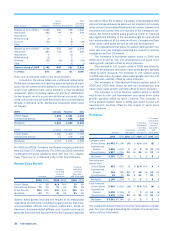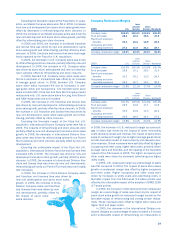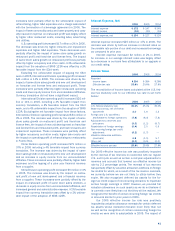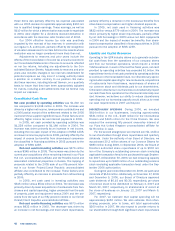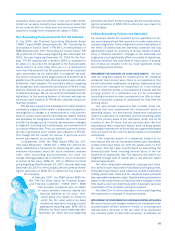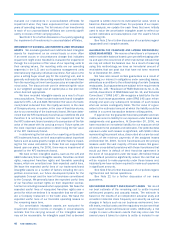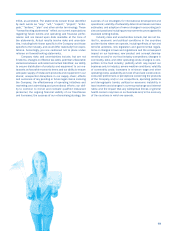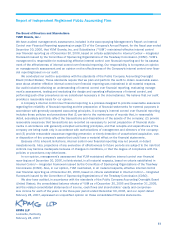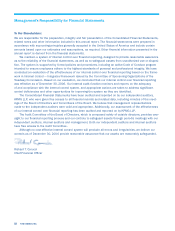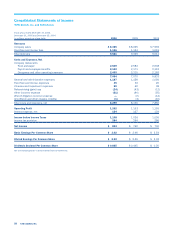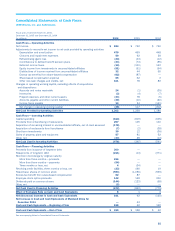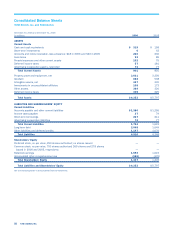Pizza Hut 2006 Annual Report Download - page 43
Download and view the complete annual report
Please find page 43 of the 2006 Pizza Hut annual report below. You can navigate through the pages in the report by either clicking on the pages listed below, or by using the keyword search tool below to find specific information within the annual report.
48 YUM! BRANDS, INC.
granted under the RGM Plan will be forfeited and approxi-
mately 20% of all awards granted to above-store executives
will be forfeited.
INCOME TAX VALUATION ALLOWANCES AND TAX RESERVES
At December 30, 2006, we have a valuation allowance of
$342 million primarily to reduce our net operating loss and
tax credit carryforward benefit of $331 million, as well our
other deferred tax assets, to amounts that will more likely
than not be realized. The net operating loss and tax credit car-
ryforwards exist in federal, state and foreign jurisdictions and
have varying carryforward periods and restrictions on usage.
The estimation of future taxable income in these jurisdictions
and our resulting ability to utilize net operating loss and tax
credit carryforwards can significantly change based on future
events, including our determinations as to the feasibility of
certain tax planning strategies. Thus, recorded valuation allow-
ances may be subject to material future changes.
As a matter of course, we are regularly audited by fed-
eral, state and foreign tax authorities. We provide reserves
for potential exposures when we consider it probable that a
taxing authority may take a sustainable position on a matter
contrary to our position. We evaluate these reserves, includ-
ing interest thereon, on a quarterly basis to insure that they
have been appropriately adjusted for events, including audit
settlements, that may impact our ultimate payment for such
exposures.
See Note 20 for a further discussion of our income taxes
and Note 22 for further discussion of certain proposed Inter-
nal Revenue Service adjustments.
Quantitative and Qualitative Disclosures
About Market Risk
The Company is exposed to financial market risks associ-
ated with interest rates, foreign currency exchange rates and
commodity prices. In the normal course of business and in
accordance with our policies, we manage these risks through
a variety of strategies, which may include the use of derivative
financial and commodity instruments to hedge our underlying
exposures. Our policies prohibit the use of derivative instru-
ments for trading purposes, and we have procedures in place
to monitor and control their use.
INTEREST RATE RISK We have a market risk exposure to
changes in interest rates, principally in the United States.
We attempt to minimize this risk and lower our overall bor-
rowing costs through the utilization of derivative financial
instruments, primarily interest rate swaps. These swaps are
entered into with financial institutions and have reset dates
and critical terms that match those of the underlying debt.
Accordingly, any change in market value associated with inter-
est rate swaps is offset by the opposite market impact on
the related debt.
At December 30, 2006 and December 31, 2005, a hypo-
thetical 100 basis point increase in short-term interest rates
would result, over the following twelve-month period, in a reduc-
tion of approximately $8 million and $7 million, respectively,
in income before income taxes. The estimated reductions
are based upon the level of variable rate debt and assume
no changes in the volume or composition of debt. In addi-
tion, the fair value of our derivative financial instruments at
December 30, 2006 and December 31, 2005 would decrease
approximately $32 million and $39 million, respectively. The
fair value of our Senior Unsecured Notes at December 30,
2006 and December 31, 2005 would decrease approximately
$69 million and $59 million, respectively. Fair value was deter-
mined by discounting the projected cash flows.
FOREIGN CURRENCY EXCHANGE RATE RISK The combined
International Division and China Division operating profits con-
stitute approximately 48% of our operating profit in 2006,
excluding unallocated income (expenses). In addition, the
Company’s net asset exposure (defined as foreign currency
assets less foreign currency liabilities) totaled approxi-
mately $1.4 billion as of December 30, 2006. Operating in
international markets exposes the Company to movements
in foreign currency exchange rates. The Company’s primary
exposures result from our operations in Asia-Pacific, Europe
and the Americas. Changes in foreign currency exchange
rates would impact the translation of our investments in
foreign operations, the fair value of our foreign currency
denominated financial instruments and our reported foreign
currency denominated earnings and cash flows. For the fiscal
year ended December 30, 2006, operating profit would have
decreased $78 million if all foreign currencies had uniformly
weakened 10% relative to the U.S. dollar. The estimated reduc-
tion assumes no changes in sales volumes or local currency
sales or input prices.
We attempt to minimize the exposure related to our invest-
ments in foreign operations by financing those investments
with local currency debt when practical. In addition, we attempt
to minimize the exposure related to foreign currency denomi-
nated financial instruments by purchasing goods and services
from third parties in local currencies when practical. Conse-
quently, foreign currency denominated financial instruments
consist primarily of intercompany short-term receivables and
payables. At times, we utilize forward contracts to reduce our
exposure related to these intercompany short-term receiv-
ables and payables. The notional amount and maturity dates
of these contracts match those of the underlying receivables
or payables such that our foreign currency exchange risk
related to these instruments is eliminated.
COMMODITY PRICE RISK We are subject to volatility in food
costs as a result of market risk associated with commodity
prices. Our ability to recover increased costs through higher
pricing is, at times, limited by the competitive environment
in which we operate. We manage our exposure to this risk
primarily through pricing agreements as well as, on a limited
basis, commodity future and option contracts. Commodity
future and option contracts entered into for the fiscal years
ended December 30, 2006, and December 31, 2005, did not
significantly impact our financial position, results of opera-
tions or cash flows.
Cautionary Statements
From time to time, in both written reports and oral state-
ments, we present “forward-looking statements” within the
meaning of Section 27A of the Securities Act of 1933, as
amended, and Section 21E of the Securities Exchange Act of


